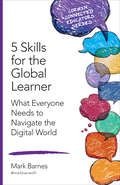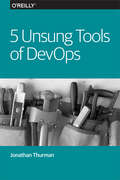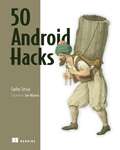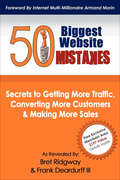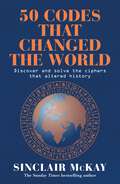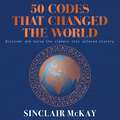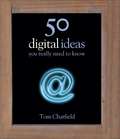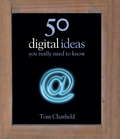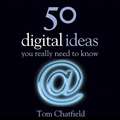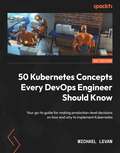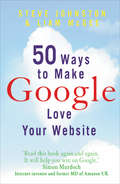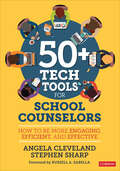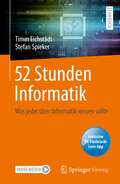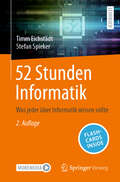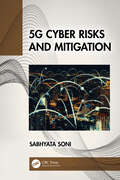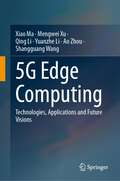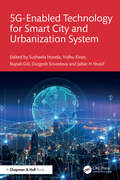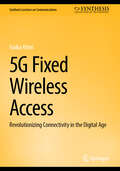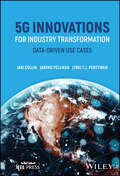- Table View
- List View
5 Skills for the Global Learner: What Everyone Needs to Navigate the Digital World (Corwin Connected Educators Series)
by Mark D. BarnesTap the power of digital learning! In today’s digital world, distance and cultural differences are inconsequential. Technology empowers students and provides them with unlimited resources and opportunities. With this easy guide, you’ll learn the five essential skills to transform students into global learners: Creating and sharing digital information Using social media Digital publishing Building a personal learning network Using aggregators to create, maintain, and share content Loaded with tips and examples for using PLNs, Facebook, Twitter, Skype, YouTube, Jing, and other essential tools, this breakthrough guide to incredible learning opportunities will keep you and your students a step ahead! The Corwin Connected Educators series is your key to unlocking the greatest resource available to all educators: other educators. Being a Connected Educator is more than a set of actions: it’s a belief in the potential of technology to fuel lifelong learning. "It′s a fact that not just our children, but all of us, are global learners. Equipping global educators who are comfortable navigating rapidly shifting digital platforms is vital. Mark Barnes cogently shows this in 5 Skills for the Global Learner, where the emphasis is on building digital skills and digital literacy. This book is a great addition to the Connected Educator′s toolkit." — Homa S. Tavangar, Author, Growing Up Global (Random House) and The Global Education Toolkit for Elementary Learners (Corwin) "Educators, parents, and businesses around the world wonder if we are preparing today’s youth for the challenges they will face tomorrow in our interconnected world. Both new and experienced teachers will appreciate these 5 essential skills that encourage communication and collaboration throughout the digital world. As a teacher and advocate of global education, I believe these resources and tips launch the foundation our students need for the 21st century." — Becky Morales, Author of The Global Education Toolkit for Elementary Learners (Corwin) and Founder of kidworldcitizen.org
5 Unsung Tools of DevOps
by Jonathan ThurmanThe tools we use play a critical role in how effective we are. In today’s ever-changing world of technology, we tend to focus on the latest and greatest solutions and overlook the simple tools that are available. Constant improvement of tools is an important aspect of the DevOps movement, but improvement doesn’t always warrant replacement.The tools presented in 5 Unsung Tools of DevOps provide insight into or control over a DevOps environment--and they require minimal installation and configuration. They're not the flashiest tools, but they're time tested and just work.
5 Very Good Reasons to Punch a Dolphin in the Mouth (And Other Useful Guides)
by The OatmealIn Matthew Inman's New York Times best selling 5 Very Good Reasons to Punch a Dolphin in the Mouth (And Other Useful Guides), samurai sword-wielding kittens and hamsters that love .50-caliber machine guns commingle with a cracked out Tyrannosaur that is extremely hard to potty train. Bacon is better than true love and you may awake in the middle of the night to find your nephew nibbling on your toes. Sixtry of Inman's comic illustrations and life-bending guides are presented in full-color inside 5 Very Good Reasons to Punch a Dolphin in the Mouth (And Other Useful Guides). Consider such handy advice as: 4 Reasons to Carry a Shovel at All Times, 6 Types of Crappy Hugs, 8 Ways to Tell if Your Loved One Plans to Eat You, 17 Things Worth Knowing About Your Cat, and 20 Things Worth Knowing About Beer.
5,203 Things to Do Instead of Looking at Your Phone
by Barbara Ann KipferBecause life is calling. Put down your phone, close the lid on your laptop, and get back in touch with the wonders of the world around you. With thousands of ideas for simple, beautiful things to do instead of scrolling down the rabbit hole of cyberspace, this healing little book offers the opportunity, 5,203 times, to slow down, look up, and rediscover what makes you feel nourished and grounded as a human being. With illustrations throughout by Scot Ritchie.
50 Android Hacks
by Carlos SessaSummaryThe best programming techniques are often the shortest and simplest—the hacks. In this compact and infinitely useful book, Android expert Carlos Sessa delivers 50 hacks that will save you time, stretch your skills, and maybe even make you smile.About this BookHacks. Clever programming techniques to solve thorny little problems. Ten lines of code that save you two days of work. The little gems you learn from the old guy in the next cube or from the geniuses on Stack Overflow. That's just what you'll find in this compact and useful book.The name 50 Android Hacks says it all. Ranging from the mundane to the spectacular, each self-contained, fully illustrated hack is just a couple of pages long and includes annotated source code. These practical techniques are organized into twelve collections covering layout, animations, patterns, and more.What's InsideHack 3 Creating a custom ViewGroupHack 8 Slideshow using the Ken Burns effectHack 20 The Model-View-Presenter patternHack 23 The SyncAdapter patternHack 31 Aspect-oriented programming in AndroidHack 34 Using Scala inside AndroidHack 43 Batching database operationsPlus 43 more hacks!Most hacks work with Android 2.x and greater. Version-specific hacks are clearly marked.Purchase of the print book includes a free eBook in PDF, Kindle, and ePub formats from Manning Publications.About the AuthorCarlos Sessa is a passionate professional Android developer. He's active on Stack Overflow and is an avid hack collector.Table of ContentsWorking your way around layoutsCreating cool animationsView tips and tricksToolsPatternsWorking with lists and adaptersUseful librariesInteracting with other languagesReady-to-use snippetsBeyond database basicsAvoiding fragmentationBuilding tools
50 Biggest Website Mistakes: Secrets to Getting More Traffic, Converting More Customers & Making More Sales
by Bret Ridgway Frank Deardurff III50 Biggest Website Mistakes is for you if: You want to improve the appearance of your website, You want your website to convert more visitors into buyers, You want to get visitors to stay longer on your site, You want to have a better understanding of what your webmaster should be doing for you, and You want to learn some of the trick of the trace that will set your site apart from your competition. This book was written to help people get more success out of their website and online business. The information comes from the combined efforts of Frank Deardurff III and Bret Ridgway, who together have well over 25 years of online marketing experience and have an established presence in the online marketing community. You’ll find that the information contained in the book can quickly become your “Checklist” for your online business -- either for yourself or your marketing assistant.
50 Codes that Changed the World: . . . And Your Chance to Solve Them!
by Sinclair McKayA CUNNING CHRONICLE OF THE 50 CODES THAT ALTERED THE COURSE OF HISTORY AND CHANGED THE WORLDFrom the bestselling author of Bletchley Park Brainteasers and The Scotland Yard Puzzle Book. There have been secret codes since before the Old Testament, and there were secret codes in the Old Testament too. Almost as soon as writing was invented, so too were the devious means to hide messages and keep them under the wraps of secrecy.In 50 Codes that Changed the World, Sinclair McKay explores these uncrackable codes, secret cyphers and hidden messages from across time to tell a new history of a secret world. From the temples of Ancient Greece to the court of Elizabeth I; from antique manuscripts whose codes might hold prophecies of doom to the modern realm of quantum mechanics, you will see how a few concealed words could help to win wars, spark revolutions and even change the faces of great nations.Here is the complete guide to the hidden world of codebreaking, with opportunities for you to see if you could have cracked some of the trickiest puzzles and lip-chewing codes ever created. -----------------------Praise for Sinclair McKay's books:'This book [The Secret Life of Bletchley Park] seems a remarkably faithful account of what we did, why it mattered, and how it all felt at the time by someone who couldn't possibly have been born then. - THE GUARDIAN[Bletchley Park Brainteasers] is outrageously difficult but utterly fascinating. - THE EXPRESS'Sinclair McKay's account of this secret war of the airwaves in [Secret Listeners] is as painstakingly researched and fascinating as his bestselling The Secret Life Of Bletchley Park, and an essential companion to it.' - DAILY MAIL
50 Codes that Changed the World: . . . And Your Chance to Solve Them!
by Sinclair McKayA CUNNING CHRONICLE OF THE 50 CODES THAT ALTERED THE COURSE OF HISTORY AND CHANGED THE WORLD . . . AND YOUR CHANCE TO SOLVE THEM!There have been secret codes since before the Old Testament, and there were secret codes in the Old Testament too. Almost as soon as writing was invented, so too were the devious means to hide messages and keep them under the wraps of secrecy.In 50 Codes that Changed the World, Sinclair McKay explores these uncrackable codes, secret cyphers and hidden messages from across time to tell a new history of a secret world. From the temples of Ancient Greece to the court of Elizabeth I; from antique manuscripts whose codes might hold prophecies of doom to the modern realm of quantum mechanics, you will see how a few concealed words could help to win wars, spark revolutions and even change the faces of great nations.Here is the complete guide to the hidden world of codebreaking, with opportunities for you to see if you could have cracked some of the trickiest puzzles and lip-chewing codes ever created. -----------------------Praise for Sinclair McKay's books:'This book [The Secret Life of Bletchley Park] seems a remarkably faithful account of what we did, why it mattered, and how it all felt at the time by someone who couldn't possibly have been born then. - THE GUARDIAN[Bletchley Park Brainteasers] is outrageously difficult but utterly fascinating. - THE EXPRESS'Sinclair McKay's account of this secret war of the airwaves in [Secret Listeners] is as painstakingly researched and fascinating as his bestselling The Secret Life Of Bletchley Park, and an essential companion to it.' - DAILY MAIL(P) 2022 Headline Publishing Group Ltd
50 Digital Ideas You Really Need to Know
by Tom ChatfieldWe are in the throes of a revolution, yet most of us are so disorientated by the rapid pace of technological and cultural change that we find it difficult to understand what's going on. 50 Digital Ideas you Really Need to Know aims to provide a clear path through the confusion and misinformation surrounding those technologies that, for better or for worse, are transforming the world we live in and even the sort of people we are.Leading technology writer Tom Chatfield is a sure-footed guide to the seminal digital phenomena of our time, from the basic browsers that we use to surf the web and update our status on social networking sites, through to the implications for privacy of our permanently distracted world, to the culture jamming that is making it increasingly difficult for traditional power structures to impose their authority. Whether plumbing the depths of the deep web that represents well over 99 percent of the internet and remains inaccessible to most search engines, to digital distribution which threatens to sweep away entire industries, to the augmented reality that will soon change the very way we interact with the world, this is an indispensable road map for the inevitable journey to a digital future.From malware to mashups; from spam to the semantic web; and from email to avatars, this book is essential reading for anyone who wants to understand the profound social and behavioural changes wrought by the emerging digital age.
50 Digital Ideas You Really Need to Know
by Tom ChatfieldWe are in the throes of a revolution, yet most of us are so disorientated by the rapid pace of technological and cultural change that we find it difficult to understand what's going on. 50 Digital Ideas you Really Need to Know provides a clear path through the confusion and misinformation surrounding those technologies that, for better or for worse, are transforming the world we live in and even the sort of people we are.Leading technology writer Tom Chatfield is a sure-footed guide to the seminal digital phenomena of our time, from the basic browsers that we use to surf the web and update our status on social networking sites, through to the implications for privacy of our permanently distracted world, to the culture jamming that is increasingly being used by protest movements, this is essential reading for anyone who wants to understand the profound social and behavioural changes wrought by the emerging digital age.
50 Digital Ideas You Really Need to Know (50 Ideas You Really Need to Know series)
by Tom ChatfieldWe are in the throes of a revolution, yet most of us are so disorientated by the rapid pace of technological and cultural change that we find it difficult to understand what's going on. 50 Digital Ideas you Really Need to Know provides a clear path through the confusion and misinformation surrounding those technologies that, for better or for worse, are transforming the world we live in and even the sort of people we are.Leading technology writer Tom Chatfield is a sure-footed guide to the seminal digital phenomena of our time, from the basic browsers that we use to surf the web and update our status on social networking sites, through to the implications for privacy of our permanently distracted world, to the culture jamming that is increasingly being used by protest movements, this is essential reading for anyone who wants to understand the profound social and behavioural changes wrought by the emerging digital age.
50 Digital Ideas You Really Need to Know: You Really Need to Know (50 Ideas You Really Need to Know series)
by Tom ChatfieldWe are in the throes of a revolution, yet the rapid pace of technological and cultural change makes it difficult to understand what's going on. 50 Ideas You Really Need to Know: Digital provides a clear path through the misinformation surrounding those technologies that are transforming the world. Leading technology writer Tom Chatfield provides a sure-footed guide to the seminal digital phenomena of our time: from the basic browsers that we use to surf the web, to the implications for our own privacy. From plumbing the depths of the deep web that represents well over 99 per cent of the internet and remains inaccessible to most search engines, to digital distribution that threatens to sweep away entire industries, this is an indispensable road map for our journey to a digital future.(P)2011 Quercus Editions Ltd
50 Kubernetes Concepts Every DevOps Engineer Should Know: Your go-to guide for making production-level decisions on how and why to implement Kubernetes
by Luca Massaron Michael LevanA must-have Kubernetes book to learn key concepts for succeeding in any production environment, be it a greenfield Kubernetes environment or your cloud-native journeyKey FeaturesAdvance in your Kubernetes journey with guidance from a seasoned k8s practitioner and trainerDiscover best practices for implementing Kubernetes in any production environmentGo beyond the basics and work with Kubernetes applications in every environmentBook DescriptionKubernetes is a trending topic among engineers, CTOs, CIOs, and other technically sound professionals. Due to its proliferation and importance for all cloud technologies, DevOps engineers nowadays need a solid grasp of key Kubernetes concepts to help their organization thrive.This book equips you with all the requisite information about how Kubernetes works and how to use it for the best results. You'll learn everything from why cloud native is important to implementing Kubernetes clusters to deploying applications in production. This book takes you on a learning journey, starting from what cloud native is and how to get started with Kubernetes in the cloud, on-premises, and PaaS environments such as OpenShift. Next, you'll learn about deploying applications in many ways, including Deployment specs, Ingress Specs, and StatefulSet specs. Finally, you'll be comfortable working with Kubernetes monitoring, observability, and security. Each chapter of 50 Kubernetes Concepts Every DevOps Engineer Should Know is built upon the previous chapter, ensuring that you develop practical skills as you work through the code examples in GitHub, allowing you to follow along while giving you practical knowledge.By the end of this book, you'll be able to implement Kubernetes in any environment, whether it's an existing environment, a greenfield environment, or your very own lab running in the cloud or your home.What you will learnFind out how Kubernetes works on-premises, in the cloud, and in PaaS environmentsWork with networking, cluster management, and application deploymentUnderstand why cloud native is crucial for Kubernetes applicationsDeploy apps in different states, including Stateless and StatefulMonitor and implement observability in your environmentExplore the functioning of Kubernetes security at the cluster, user, and application levelWho this book is forThis book is for cloud engineers, developers, DevOps engineers, and infrastructure engineers responsible for inheriting a Kubernetes environment or creating a greenfield Kubernetes environment. If you are a professional who wants to get started with cloud-native applications and implement k8s best practices, then this book is a must-read. If you have engineered environments in the cloud and on-premises and understand how to deploy applications with a solid tenure in a developer role, this book will help you further your skills.
50 Tips and Tricks for MongoDB Developers: Get the Most Out of Your Database
by Kristina ChodorowGetting started with MongoDB is easy, but once you begin building applications with it, you'll face some complex issues. What are the tradeoffs between normalized and denormalized data? How do you handle replica set failure and failover? This collection of MongoDB tips, tricks, and hacks helps you resolve issues with everything from application design and implementation to data safety and monitoring.You get specific guidance in five topic areas directly from engineers at 10gen, the company that develops and supports this open source database:Application Design Tips: What to keep in mind when designing your schemaImplementation Tips: Programming applications against MongoDBOptimization Tips: Speeding up your applicationsData Safety Tips: Using replication and journaling to keep data safe—without sacrificing too much performanceAdministration Tips: How to configure MongoDB and keep it running smoothly
50 Top IT Project Management Challenges
by Premanand Doraiswamy Premi ShivA summary of the challenges facing today's IT project managerDiscussions on project management forums highlight many of the challenges facing a project manager during the course of a project. Unclear requirements, scope creep and undefined roles are well-trodden issues that can derail a project. Other challenges are less obvious, often more subtle, but equally destructive. Facing up to the challengesThis book offers a focused and concise summary of 50 challenges facing today's IT project manager. The authors draw on years of practical experience (rather than classroom theory) to outline these challenges and offer useful tips and advice on how to deal with them. Challenge and responseReaders of this book will be better equipped to respond to key project management challenges, includingBuilding the team - getting the right resources, matching skills/knowledge, defining roles and responsibilities. Project scope - clarifying assumptions, avoiding ambiguity, getting the time/cost estimates right. Politics - communicating with management and stakeholders, dealing with conflict, handling interference and micro-managing. Risk awareness - identifying inside/outside influences, recognising inbound and outbound dependencies. Time management - using the right planning tools, balancing work versus meetings. Failure - handling the blame game, protecting the team, rescuing the project. This book condenses into a handy summary much of the information and advice that can be found in project management related books and discussion forums. It is an ideal reference for anyone involved in IT project management, from professional service organisations (PSO) and project management offices (PMO), through to active project managers and studying graduates.
50 Ways to Make Google Love Your Website
by Liam McGee Steve JohnstonGoogle is now a dominant force on the Internet, guiding millions of searches and online purchases every day. Understanding how it works and how to make the most of it is therefore essential to anyone building or running a website, whether for business or as a hobby. This easy-to-follow guide explains not only how Google actually sifts the billions of pages of information its index contains, but shows you how you can improve the performance of your own website in Google's search results, giving specific and detailed instructions about the sort of priority issues you need to address. 50 Ways to Make Google Love Your Website will teach you how to:- Use Google to help you understand how people search for the sort of things you are offering- Create a website that your customers will quickly find in Google- Make your website irresistible to links from other sites- Help Google understand what your site is about- Think like Google and win more traffic
50+ Tech Tools for School Counselors: How to Be More Engaging, Efficient, and Effective
by Angela Cleveland Stephen SharpDigital tools that will transform your practice Educating students in the 21st century is about more than preparing them for work in the digital age; it′s also about connecting with the whole student and transcending barriers. Written for school counselors and other education professionals, 50+ Tech Tools for School Counselors provides insightful descriptions of digital tools that can be used daily to not only enrich intervention and instruction but also guide decision-making, streamline work, enhance communication, and promote happier students. Readers will find: a framework for leadership and advocacy through the lens of technology vignettes demonstrating implementation and quotes from students and other stakeholders step-by-step guides and checklists perspectives from counselors around the country that provide a peer-to-peer feel narratives, technical descriptions, and diagrams School counselors are often unsure or unaware of the myriad of existing tech tools. This book will help them enhance their practice, feel more confident, spend less time on paperwork, and enable today’s students to achieve success in school and access information on college and careers.
50+ Tech Tools for School Counselors: How to Be More Engaging, Efficient, and Effective
by Angela Cleveland Stephen SharpDigital tools that will transform your practice Educating students in the 21st century is about more than preparing them for work in the digital age; it′s also about connecting with the whole student and transcending barriers. Written for school counselors and other education professionals, 50+ Tech Tools for School Counselors provides insightful descriptions of digital tools that can be used daily to not only enrich intervention and instruction but also guide decision-making, streamline work, enhance communication, and promote happier students. Readers will find: a framework for leadership and advocacy through the lens of technology vignettes demonstrating implementation and quotes from students and other stakeholders step-by-step guides and checklists perspectives from counselors around the country that provide a peer-to-peer feel narratives, technical descriptions, and diagrams School counselors are often unsure or unaware of the myriad of existing tech tools. This book will help them enhance their practice, feel more confident, spend less time on paperwork, and enable today’s students to achieve success in school and access information on college and careers.
52 Stunden Informatik: Was jeder über Informatik wissen sollte
by Timm Eichstädt Stefan SpiekerDas Buch vermittelt Allgemeinbildung der Informatik. Alle 52 Lektionen haben einen starken praktischen Bezugzeigen Konzepte/Tools/Technologien auf dem aktuellen Stand der Technikbeschreiben zentrale Begriffe der Informatik mit Erläuterungen, Beispielen, praktischen Übungen, Hinweisen, Diskussionspunkten und weiterführenden Linkssind vom Umfang überschaubar (circa 1 Stunde)Die Priorität liegt auf aktuellen Inhalten und wertvollem Grundlagenwissen mit vielen praktischen Beispielen und Ideen zur Wissensvermittlung. Zusätzlich stehen für Leserinnen und Leser über die Springer Nature Flash-cards-App digitale Lernkarten zum Buch zur Wissenskontrolle und -vertiefung kostenlos zur Verfügung.
52 Stunden Informatik: Was jeder über Informatik wissen sollte
by Timm Eichstädt Stefan SpiekerHaben Sie in Ihrer Schulzeit keinen oder nur mangelhaften Informatikunterricht erhalten? Haben Sie Kinder und würden diese gerne auf das bevorstehende Informationszeitalter vorbereiten? Nehmen Sie sich in den nächsten 52 Wochen je eine Stunde Zeit um mithilfe dieses Buches ein solides Grundwissen über Informatik zu schaffen! 52 Stunden Informatik enthält eine breit gefächerte Zusammenstellung von Lektionen, zum Lernen bzw. Lehren von Grundwissen der Informatik. Vom Nutzen des Internets bis hin zur Informationssicherheit, von deskriptiver Statistik bis hin zum neuronalen Netz sind viele wichtige Aspekte der Informatik abgedeckt. Alle Lektionen enthalten pädagogisch wertvolle Hinweise und sind mit praktischen Übungen versehen. Eine Pflichtlektüre für alle praxisorientierten Informatiklehrer*innen und Eltern, die selbst einen angemessenen Informatikunterricht verpasst haben. Die neue Auflage aktualisiert und erweitert viele Kapitel (z.B. ist das Thema "ChatGPT" im Kapitel über künstliche Intelligenz mit aufgenommen) und enthält ein neues Kapitel über 3D-Druck.
5G Cyber Risks and Mitigation
by Sabhyata Soni5 G technology is the next step in the evolution of wireless communication. It offers faster speeds and more bandwidth than 4G. One of the biggest differences between 4G and 5G is that 5G will be used for a wider range of applications. This makes it ideal for applications such as autonomous vehicles, smart cities, and the internet of things. This means that there will be more devices connected to 5G networks, making them more vulnerable to cyber attacks. However, 5 G also introduces new cyber risks that need to be addressed. In addition, 5 G networks are expected to be much more complex, making them harder to secure. 5G networks will use new technologies that could make them more vulnerable to attack. These technologies include massive MIMO (multiple input, multiple output), which uses more antennas than traditional cellular networks, and millimeter wave (mmWave), which uses higher frequencies than traditional cellular networks. These new technologies could make it easier for attackers to intercept data or disrupt service. To address these concerns, security measures must be implemented throughout the network. Security mechanisms must be included in the design of 5G networks and must be updated as new threats are identified. Moreover, to address these risks, 5 G security standards need to be developed and implemented. These standards should include measures to protect against Denial of Service (DoS) attacks, malware infections, and other threats. Fortunately, artificial intelligence can play a key role in mitigating these risks. With so many interconnected devices, it can be difficult to identify and isolate malicious traffic. AI can help by identifying patterns in data that would otherwise be undetectable to humans. 6G technology is still in the early developmental stages, but security experts are already voicing concerns about the potential challenges that could arise with this next generation of mobile connectivity. Experts are already working on a roadmap for 6G deployment, and they are confident that these and other challenges can be overcome.
5G Edge Computing: Technologies, Applications and Future Visions
by Qing Li Shangguang Wang Ao Zhou Xiao Ma Mengwei Xu Yuanzhe LiEdge computing has been identified as one of the key technologies for 5G networks and beyond due to two prominent advantages: low network latency and reduced core network load. By empowering cloud capabilities and IT service environments at the network edge, edge computing can well support applications of 5G and beyond, such as augmented/virtual reality (AR/VR), vehicular network (ultra-reliable low-latency communication services),Internet of Things (massive machine type communication services), and mobile high-definition video (enhanced mobile broadband services). Therefore, edge computing has attracted the attention of both industry and academia since its emergence. This book highlights the progress of 5G edge computing in both industry and academia according to our long-term efforts, including the current practice of public edge providers, the research process of edge computing from academia, the integration of edge computing with 5G, and the future visions of edge computing in the 6G era. From this book, the readers can benefit from: (1) the first comprehensive measurement study on a leading public edge platform, NEP (next-generation edge platform); 2) a clear and in-depth introduction of the key technologies of 5G edge computing; (3) the latest progress of 5G-integrated edge computing; and (4) pioneering exploration of 6G edge computing based on Tiansuan constellation – an open satellite-terrestrial integrated platform. Both the researchers from academia or practitioners from industry can benefit significantly from this book.
5G Enabled Technology for Smart City and Urbanization System
by Susheela Hooda Durgesh Srivastava Jabar H. Yousif Vidhu Kiran Rupali GillThis book examines the applications, trends and challenges of 5G Enabled technologies for Smart City and Urbanization systems. It addresses the challenges to bringing such capabilities of 5G-enabled technologies for smart cities and urbanisation into practice by presenting the theoretical as well as technical research outcomes with case studies. It covers key areas, including smart building, smart health care, smart mobility, smart living, smart surveillance, and IOT-based systems. It explains how these systems are connected using different technologies that support 5G access and control protocols.• Offers a comprehensive understanding of the emergence of 5G technology and its integration with IoT, Big Data, and Artificial Intelligence for smart city and urbanisation• Focuses on useful applications of Smart City and Urbanization, which can enhance different aspects of urban life• Explores the advantages of using massive IoT and predictive analytics approaches in smart cities• IoT, Bigdata, Deep learning and machine learning techniques are explained to fuel smart city and Urbanization system• Addresses both theoretical and technical research outcomes related to smart city and urbanisation with 5G technology.It serves as a valuable reference for graduate students, researchers, and m practitioners seeking to deepen their knowledge and engage with the latest advancements in the areas of Smart cities and Urbanization systems.
5G Fixed Wireless Access: Revolutionizing Connectivity in the Digital Age (Synthesis Lectures on Communications)
by Isiaka AlimiThis book explores the transformative potential of 5G technology in delivering high-speed broadband services through wireless means, particularly targeting underserved and rural areas. The book covers several key topics, including high-frequency spectrum bands, advanced transmission schemes, multi-connectivity, adaptive numerology, and Integrated Access and Backhaul (IAB). These elements are critical for enhancing network performance, increasing capacity, and reducing latency. High-frequency spectrum bands, such as those above 24 GHz, are essential for providing the necessary bandwidth to support high data rates and capacity. The book explains how these bands, while offering unprecedented peak rates, present challenges such as limited coverage and penetration, which are addressed through advanced technical solutions. Advanced transmission schemes, including massive beamforming and Multiple-Input Multiple-Output, are explored in detail. These technologies enable the efficient use of the spectrum by allowing multiple user terminals to be served simultaneously on the same frequency resources, thereby increasing the overall network capacity and improving user experiences. Multi-connectivity and adaptive numerology are also key topics. Multi-connectivity allows user equipment to connect to multiple network nodes simultaneously, improving reliability and performance. Adaptive numerology, defined in 3GPP Release 15, supports a flexible range of subcarrier spacing to cater to different services, quality of service requirements, latency needs, and frequency ranges. IAB is another significant topic covered in the book. IAB leverages the same spectrum for both access and backhaul, simplifying deployment and reducing costs. By using the 5G infrastructure to support backhaul, it eliminates the need for extensive fiber installations, making it easier to extend high-speed connectivity to remote and rural areas. These topics are crucial as they collectively address the limitations of traditional wired infrastructure, which is often costly and time-consuming to deploy in rural and hard-to-reach areas. By leveraging 5G Fixed Wireless Access (FWA), the book sets out to solve the problem of the digital divide, aiming to make high-speed internet more accessible and affordable. The relevance of these solutions is underscored by the growing global demand for reliable, high-speed internet access. As the book outlines, 5G FWA not only enhances broadband services but also plays a pivotal role in bridging the digital divide, ensuring that more people, regardless of their location, can benefit from the advancements in internet technology. This makes "5G FWA " an essential read for understanding the future of broadband connectivity and the strategic approaches needed to overcome deployment challenges. This book is intended to be a definitive guide for professionals, researchers, policymakers, and anyone interested in understanding the nuances and implications of this transformative technology.
5G Innovations for Industry Transformation: Data-driven Use Cases
by Jyrki T. Penttinen Jari Collin Jarkko Pellikka5G INNOVATIONS FOR INDUSTRY TRANSFORMATION Authoritative resource providing insight on real-life industrial 5G use cases in driving customer value, productivity, and sustainability ambitions With 5G innovations rapidly expanding to different areas within technology, 5G Innovations for Industry Transformation provides key information on how 5G technology can positively impact digital transformation in the industry sectors, discussing new data-driven business opportunities, including green digital transition, new standards for sustainability, and real-time data-driven services, introducing case studies that cover a variety of industries, from the oil & gas industry to the telecom industry, along with the lessons learned from these case studies, and providing insights into how 5G technology will transform businesses by sharing real-time customer solutions, fair data sharing principles, and ecosystem and change management. The book summarizes novelty aspects in a compact and practical way to benefit users and specialists in the field who want to understand some of the very key aspects of 5G. To aid in reader comprehension, the book contains tables, figures of technical principles and architectural block diagrams, and photographs further explaining key topics. Sample topics covered in 5G Innovations for Industry Transformation include: 5G SA technology with new capabilities, 5G private networks, and how smart, connected products are transforming competition Implications of 5G applied to your particular business and/or industry, and how to scale up and industrialize based on these implications How to lead the charge in relation to optimizing business practices based on the advent of 5G, and details on navigating the platform economy How 5G affects data privacy and security, and other integrated capabilities of 5G, such as processes, data, technology, and competencies Based on real-world experiences and high-quality research and presenting practical examples that serve as a useful guiding hand, 5G Innovations for Industry Transformation is an essential resource for change leaders, enterprise architects, and software developers of any industrial enterprise seeking to drive digitalization forward in their value chain and organization.
